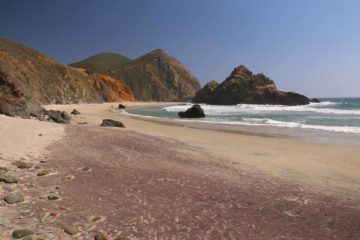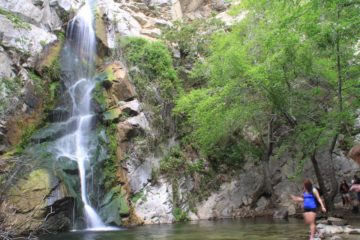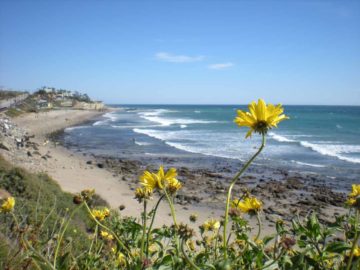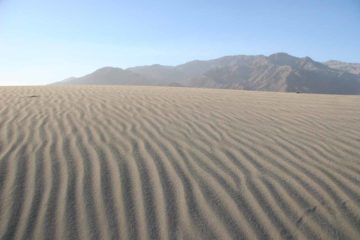About Murray Canyon Falls (Seven Sisters Falls)
Murray Canyon Falls (also referred to as the Seven Sisters Falls) was more of an adventure for us given that it took quite a bit of effort to reach compared to some of the other waterfalling excursions in the Palm Springs area (such as Tahquitz Falls). This adventure included ruining our hiking boots as we had no choice but to wade right through the dozen or more crossings of Murray Creek. Each of these creek crossings were at least ankle to shin deep when we did this hike in mid-February 2017. Yet with all the inconveniences, Julie and I found this to be a very scenic hike as we passed through desolate high desert terrain right at the foot of the San Jacinto Mountains, then followed groves of palm trees lining Murray Creek while being towered over by unusual rock formations lining Murray Canyon itself. Throughout the hike, we saw many minor cascades, but topping it all off were a pair of waterfalls – one split falls about 15-20ft high and a pair of falls (each about 10-15ft plunging one after the other) right at the end of the official trail. Although we avoided the desert heat by doing this hike in the Winter time, we could totally see the appeal of this place when the temperatures would rise as Murray Canyon seemed to fit that stereotypical definition of a desert oasis.
The hike began from an unpaved palm-tree-fringing trailhead parking area signposted for Murray Canyon (see directions below). The trail then proceeded to gently descend into a seemingly desolate flat desert area where the majority of the vegetation didn’t seem to grow any higher than one’s waist. Such sparse and low-lying vegetation made it seem like this would be the last place to find a waterfall, but this was merely an interlude to get from Andreas Canyon (the area where the car park was) to the Murray Canyon itself. This flat stretch, which lasted about a half-mile, was open enough that we noticed some interesting rock formations sticking out amongst the low-lying shrubs while we were also able to look to our right at the San Jacinto Mountains rising majestically above the basin.
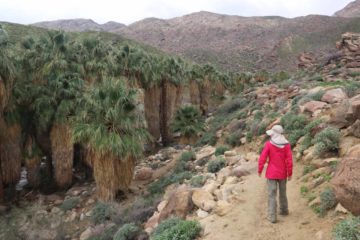
The trail would pretty much continue in this manner for the next 1.5 miles. The path would momentarily split and rejoin as there were horse paths leading to deeper but flatter and less-rockier creek crossings. There was also another trail junction where horse tours would deviate from Murray Canyon for good (so roughly the first mile or so would be shared with horse traffic from time to time). As the canyon walls would continue closing in, the creek crossings became even more frequent and trickier. Meanwhile, we’d frequently encounter minor cascades amongst Murray Creek (typically on the order of around 5-10ft or less). Even when we resigned ourselves to getting wet at each creek crossing, we still had to choose our steps wisely amongst the submerged rocks so as to not get in too deep in Murray Creek, especially where there was a current.
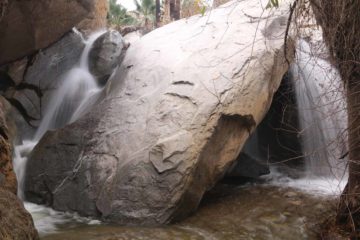
After the last of the creek crossings, the trail then rounded a bend before finally terminating at the main Murray Canyon Falls. This falls was a two-tiered falls where the first falls was a wide block-type falls while the upper one had a bit of a plunge. To get up to that upper waterfall, we saw about a dozen or so folks make the dicey-looking scramble up a steep sandstone slope to get past the first falls. Julie and I weren’t comfortable taking that risk so we opted to stay before the first waterfall and bask in our accomplishment as well as the ambience of the place.
Overall, it took us about 2 hours to get from the trailhead to the end of the official trail. By the time we returned to the trailhead, we wound up spending about 3.5 hours away from the car. Given the conditions of our hike, in hindsight, we should have brought our trekking poles as well as water sandals
. This was not the kind of excursion to let water into Gore-tex boots
where the water had nowhere to escape except when I’d lift my leg to let the water out through the top. So the water weighing down our shoes probably caused us to move even slower than our already slow pace. Either way, the entire hike was said to be about 4 miles round trip. We were told that there were about a dozen stream crossings, but I swore that we might have counted a few more than that.
Finally, Murray Canyon Falls was said to be a seasonal waterfall. Therefore, the best time to visit the falls would be when snow from the San Jacinto Mountains would melt and drain into Murray Canyon. In other words, mid-Winter through Spring would be the seasons to visit though the longevity of the creek would depend on how much precipitation would have accumulated in the mountains. Obviously during a drought (like in the past few years), the window of opportunity to visit the falls when it would be flowing would be even more diminished or non-existent altogether.
Related Top 10 Lists
No Posts Found
Trip Planning Resources
Nearby Accommodations
This content is for members only. See Membership Options.Featured Images and Nearby Attractions
This content is for members only. See Membership Options.Visitor Comments:
Got something you'd like to share or say to keep the conversation going? Feel free to leave a comment below...No users have replied to the content on this page
Visitor Reviews of this Waterfall:
If you have a waterfall story or write-up that you'd like to share, feel free to click the button below and fill out the form...No users have submitted a write-up/review of this waterfall



